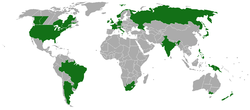Panaeolus cinctulus
| Panaeolus cinctulus | |
|---|---|

| |
| Scientific classification | |
| Domain: | Eukaryota |
| Kingdom: | Fungi |
| Division: | Basidiomycota |
| Class: | Agaricomycetes |
| Order: | Agaricales |
| Family: | Bolbitiaceae |
| Genus: | Panaeolus |
| Species: | P. cinctulus
|
| Binomial name | |
| Panaeolus cinctulus | |

| |
| Approximate Panaeolus cinctulus range | |
| Synonyms[1][2] | |
|
Agaricus cinctulus Bolton (1791) | |
| Panaeolus cinctulus | |
|---|---|
| Gills on hymenium | |
| Cap is campanulate or convex | |
| Hymenium is adnate or adnexed | |
| Stipe is bare | |
| Spore print is black | |
| Ecology is saprotrophic | |
| Edibility is psychoactive | |
Panaeolus cinctulus, syn. P. subbalteatus, commonly known as the belted panaeolus,[3] banded mottlegill, or subbs, is a very common, widely distributed psilocybin mushroom.
Etymology
[edit]The descriptor subbalteatus comes from the Latin words sub ('somewhat') and balteat ('girdled'), a reference to the dark outer band of the cap.[4]
Description
[edit]The cap is 1.5–6 centimetres (1⁄2–2+1⁄2 in) wide,[3] hemispherical to convex when young to broadly umbonate or plane in age,[4] smooth, hygrophanous, striking cinnamon-brown when moist, soot-black when wet which disappears as the mushroom completely dries out. The outer band is usually darker.[4] The flesh is thin and brownish.[3]
The gills are close, adnate to adnexed, cream-colored when young, later mottled dingy brown then to soot-black.[3] The gill edges are white and slightly fringed, but turn blackish when fully mature.[5] The spore print is black.[6]
The stipe is 4–10 cm long, 1–10 mm thick, equal or tapered at the ends, reddish brown or covered by whitish powder, hollow,[3] no veil remnants, longitudinally white-fibrillose, striate at the apex or twisting vertically down the entire length of the stipe. The stem base and mycelium occasionally stain blue.[3]
The taste is farinaceous (like flour) when fresh, saliferous (salty) when dried. The odor is slightly farinaceous.
Microscopic features
[edit]The spores are 11–16 x 7.5–10 x 6–9 μm, smooth, elliptical to rhomboid in face view, thick-walled, elliptical in side view.
Similar species
[edit]Morphologically, P. cinctulus can be easily confused with other species of psilocybin mushrooms.[3] They have a resemblance to P. fimicola and prefer the same habitats, but the latter species has sulphidia on the gill faces.
It can also resemble P. foenisecii and P. olivaceus.[6]
Habitat and formation
[edit]Panaeolus cinctulus is a cosmopolitan species that grows solitary to gregarious to cespitose (densely clumped) on compost piles, well-fertilized lawns and gardens, and, rarely, directly on horse dung.[7] It grows from spring to fall, abundantly after rain. It can be found in many regions, including: Africa[8] (South Africa),[8] Austria,[8][9] Canada (Alberta, British Columbia, New Brunswick, Prince Edward Island, Ontario, Quebec, Nova Scotia),[8] Denmark,[9] Finland,[10] France,[8] Germany,[8][9] Great Britain,[8] Guadeloupe,[9] Estonia,[8] Iceland,[8] India,[8] Ireland,[8] Italy,[8] South Korea,[8] Japan,[8] Mexico,[10] New Guinea,[8] New Zealand,[8] Norway,[9] Philippines,[8] Russia,[8] Slovenia,[9] South America (Argentina, Chile, Brazil)[8] and the United States (common in Oregon, Alaska, Washington, and both northern and southern California, but known to occur in all 50 states).[citation needed]
According to American mycologist David Arora, P. cinctulus is the most common psilocybin mushroom in California. [3]
It has also been sighted in Melbourne, Australia, Central Queensland, Australia Belgium and the Czech Republic.[citation needed]
Legality
[edit]The legal status of psilocybin mushrooms varies worldwide. Psilocybin and psilocin are listed as Class A (United Kingdom) or Schedule I (US) drugs under the United Nations 1971 Convention on Psychotropic Substances.[11] The possession and use of psilocybin mushrooms, including P. cinctulus, is therefore prohibited by extension. However, in many national, state, and provincial drug laws, there is a great deal of ambiguity about the legal status of psilocybin mushrooms and the spores of these mushrooms. Panaeolus cinctulus is mildly psychoactive.[4]
In culture
[edit]During the early 1900s, these species were referred to as the "weed Panaeolus" because they were commonly found in beds of the commercially grown, grocery-store mushroom Agaricus bisporus. Mushroom farmers had to weed it out from the edible mushrooms because of its hallucinogenic properties.[12]
Gallery
[edit]
|
See also
[edit]References
[edit]- ^ "Panaeolus cinctulus (Bolton) Sacc. 1887". MycoBank. International Mycological Association. Retrieved 2011-05-11.
- ^ Gerhardt, E. (1996). "Taxonomische Revision der Gattungen Panaeolus und Panaeolina (Fungi, Agaricales, Coprinaceae)". Bibliotheca Botanica. 147: 1–149.
- ^ a b c d e f g h Arora, David (1986) [1979]. Mushrooms Demystified: A Comprehensive Guide to the Fleshy Fungi (2nd ed.). Berkeley, CA: Ten Speed Press. pp. 358–59. ISBN 978-0-89815-170-1.
- ^ a b c d Trudell, Steve; Ammirati, Joe (2009). Mushrooms of the Pacific Northwest. Timber Press Field Guides. Portland, OR: Timber Press. pp. 201–202. ISBN 978-0-88192-935-5.
- ^ "Panaeolus Cinctulus". Shroomery. Archived from the original on February 22, 2014. Retrieved February 12, 2014.
- ^ a b Audubon (2023). Mushrooms of North America. Knopf. p. 612. ISBN 978-0-593-31998-7.
- ^ Stamets, Paul (1996). Psilocybin Mushrooms of the World. Berkeley: Ten Speed Press. ISBN 0-9610798-0-0. p. 82.
- ^ a b c d e f g h i j k l m n o p q r s Gastón Guzmán, John W. Allen, Jochen Gartz (1998). "A worldwide geographical distribution of the neurotropic fungi, an analysis and discussion" (PDF). Annali del Museo Civico di Rovereto (14): 189–280.
{{cite journal}}: CS1 maint: multiple names: authors list (link) (on Fondazione Museo Civico di Rovereto) - ^ a b c d e f [1] Panaeolus Specimens in Various Countries (data.gbif.org)
- ^ a b Panaeolus cinctulus Mushroom Observer (mushroomobserver.org)
- ^ "List of psychotropic substances under international control" (PDF). International Narcotics Control Board. August 2003. Archived from the original (PDF) on 2012-08-31. Retrieved 2015-10-11.
- ^ Singer and Smith (1958).
Sources:
- Allen John W. (1994). Psychedelic Illuminations vol. 5: Close Encounters of the Panaeolus Kind. Los Angeles, California: Ron Piper. pp. 58–62}.
- Stamets P. (1996). Psilocybin Mushrooms of the World. Berkeley, California: Ten Speed Press. p. 82. ISBN 0-9610798-0-0.










